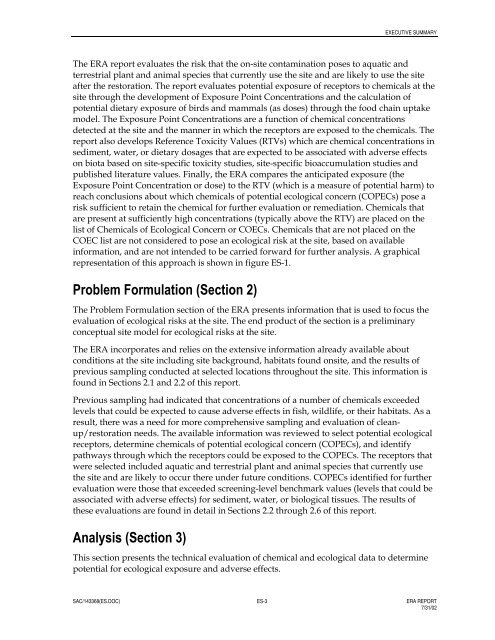1.1 MB pdf - Bolsa Chica Lowlands Restoration Project
1.1 MB pdf - Bolsa Chica Lowlands Restoration Project
1.1 MB pdf - Bolsa Chica Lowlands Restoration Project
Create successful ePaper yourself
Turn your PDF publications into a flip-book with our unique Google optimized e-Paper software.
EXECUTIVE SUMMARY<br />
The ERA report evaluates the risk that the on-site contamination poses to aquatic and<br />
terrestrial plant and animal species that currently use the site and are likely to use the site<br />
after the restoration. The report evaluates potential exposure of receptors to chemicals at the<br />
site through the development of Exposure Point Concentrations and the calculation of<br />
potential dietary exposure of birds and mammals (as doses) through the food chain uptake<br />
model. The Exposure Point Concentrations are a function of chemical concentrations<br />
detected at the site and the manner in which the receptors are exposed to the chemicals. The<br />
report also develops Reference Toxicity Values (RTVs) which are chemical concentrations in<br />
sediment, water, or dietary dosages that are expected to be associated with adverse effects<br />
on biota based on site-specific toxicity studies, site-specific bioaccumulation studies and<br />
published literature values. Finally, the ERA compares the anticipated exposure (the<br />
Exposure Point Concentration or dose) to the RTV (which is a measure of potential harm) to<br />
reach conclusions about which chemicals of potential ecological concern (COPECs) pose a<br />
risk sufficient to retain the chemical for further evaluation or remediation. Chemicals that<br />
are present at sufficiently high concentrations (typically above the RTV) are placed on the<br />
list of Chemicals of Ecological Concern or COECs. Chemicals that are not placed on the<br />
COEC list are not considered to pose an ecological risk at the site, based on available<br />
information, and are not intended to be carried forward for further analysis. A graphical<br />
representation of this approach is shown in figure ES-1.<br />
Problem Formulation (Section 2)<br />
The Problem Formulation section of the ERA presents information that is used to focus the<br />
evaluation of ecological risks at the site. The end product of the section is a preliminary<br />
conceptual site model for ecological risks at the site.<br />
The ERA incorporates and relies on the extensive information already available about<br />
conditions at the site including site background, habitats found onsite, and the results of<br />
previous sampling conducted at selected locations throughout the site. This information is<br />
found in Sections 2.1 and 2.2 of this report.<br />
Previous sampling had indicated that concentrations of a number of chemicals exceeded<br />
levels that could be expected to cause adverse effects in fish, wildlife, or their habitats. As a<br />
result, there was a need for more comprehensive sampling and evaluation of cleanup/restoration<br />
needs. The available information was reviewed to select potential ecological<br />
receptors, determine chemicals of potential ecological concern (COPECs), and identify<br />
pathways through which the receptors could be exposed to the COPECs. The receptors that<br />
were selected included aquatic and terrestrial plant and animal species that currently use<br />
the site and are likely to occur there under future conditions. COPECs identified for further<br />
evaluation were those that exceeded screening-level benchmark values (levels that could be<br />
associated with adverse effects) for sediment, water, or biological tissues. The results of<br />
these evaluations are found in detail in Sections 2.2 through 2.6 of this report.<br />
Analysis (Section 3)<br />
This section presents the technical evaluation of chemical and ecological data to determine<br />
potential for ecological exposure and adverse effects.<br />
SAC/143368(ES.DOC) ES-3 ERA REPORT<br />
7/31/02






